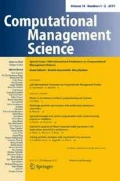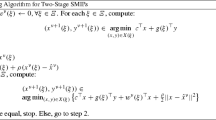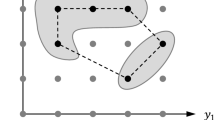Abstract
Progressive Hedging (PH) is a well-known algorithm for solving multi-stage stochastic convex optimization problems. Most previous extensions of PH for mixed-integer stochastic programs have been implemented without convergence guarantees. In this paper, we present a new framework that shows how PH can be utilized while guaranteeing convergence to globally optimal solutions of mixed-integer stochastic convex programs. We demonstrate the effectiveness of the proposed framework through computational experiments.




Similar content being viewed by others
Notes
An alternative statement of the problem is given in Rockafellar and Wets (1991). The authors pose the problem as a projected saddle function that is extended with proximal terms on the \(\hat{X}\) and \(\Lambda \) variables. The proof of convergence for the PH algorithm relies on this interpretation.
The authors use a 96-core Intel Xeon workstation with 2.1 GHz processors and 1 TB of RAM, where 50 instances of the PH algorithm are executed in parallel, and each instance is allowed to use up to 2 cores.
References
Ahmed S (2013) A scenario decomposition algorithm for 0–1 stochastic programs. Oper Res Lett 41(6):565–569
Ahmed S, Garcia R, Kong N, Ntaimo L, Parija G, Qiu F, Sen S (2015) SIPLIB: a stochastic integer programming test problem library. http://www.isye.gatech.edu/~sahmed/siplib. Accessed 5 July 2017
Angulo G, Ahmed S, Dey SS (2014) Improving the integer L-shaped method. Technical report, School of Industrial and Systems Engineering, Georgia Institute of Technology
Barnett J, Watson J-P, Woodruff DL (2017) BBPH: using Progressive Hedging within branch and bound to solve multi-stage stochastic mixed integer programs. Oper Res Lett 45(1):34–39
Birge JR (1985) Decomposition and partitioning methods for multistage stochastic linear programs. Oper Res 33(5):989–1007
Bixby RE (2002) Solving real-world linear programs: a decade and more of progress. Oper Res 50(1):3–15
Boland N, Christiansen J, Dandurand B, Eberhard A, Linderoth J, Luedtke J, Oliveira F (2016) Combining Progressive Hedging with a Frank–Wolfe method to compute Lagrangian dual bounds in stochastic mixed-integer programming. Technical report, Optimization Online
Boland NL, Eberhard AC (2014) On the augmented Lagrangian dual for integer programming. Math Program 150(2):491–509
Boyd S (2010) Distributed optimization and statistical learning via the alternating direction method of multipliers. Found Trends Mach Learn 3(1):1–122
Carøe CC, Schultz R (1999) Dual decomposition in stochastic integer programming. Oper Res Lett 24(1–2):37–45
Carøe CC, Tind J (1998) L-shaped decomposition of two-stage stochastic programs with integer recourse. Math Program 83:451–464
Escudero LF, Garín A, Merino M, Pérez G (2009) BFC-MSMIP: an exact branch-and-fix coordination approach for solving multistage stochastic mixed 0–1 problems. Top 17:96–122
Feizollahi MJ, Ahmed S, Sun A (2015) Exact augmented Lagrangian duality for mixed integer linear programming. Technical report, School of Industrial and Systems Engineering, Georgia Institute of Technology
Gade D, Hackebeil G, Ryan SM, Roger J-PW, David JW (2016) Obtaining lower bounds from the Progressive Hedging algorithm for stochastic mixed-integer programs. Math Program 157(1):47–67
Gade D, Küçükyavuz S, Sen S (2014) Decomposition algorithms with parametric Gomory cuts for two-stage stochastic integer programs. Math Program 144(1–2):39–64
Guignard M, Kim S (1987) Lagrangean decomposition: a model yielding stronger Lagrangean bounds. Math Program 39(2):215–228
Guo G, Hackebeil G, Ryan SM, Watson J-P, Woodruff DL (2015) Integration of Progressive Hedging and dual decomposition in stochastic integer programs. Oper Res Lett 43(3):311–316
Helmberg C (2000) Semidefinite programming for combinatorial optimization. Konrad-Zuse-Zentrum für Informationstechnik, Berlin
Hemmecke R, Schultz R (2003) Decomposition of test sets in stochastic integer programming. Math Program 94(2–3):323–341
Higle JL, Sen S (2006) Multistage stochastic convex programs: duality and its implications. Ann Oper Res 142(1):129–146
Horst R, Tuy H (2013) Global optimization: deterministic approaches. Springer, Berlin
Jörnsten K, Näsberg M, Smeds P (1985) Variable splitting: a new Lagrangean relaxation approach to some mathematical programming models. Technical report, Department of Mathematics, University of Linköping
Laporte G, Louveaux FV (1993) The integer L-shaped method for stochastic integer programs with complete recourse. Oper Res Lett 13(3):133–142
Løkketangen A, Woodruff DL (1996) Progressive Hedging and tabu search applied to mixed integer (0, 1) multistage stochastic programming. J Heuristics 2(2):111–128
Louveaux FV (1980) A solution method for multistage stochastic programs with recourse with application to an energy investment problem. Oper Res 28(4):889–902
Lubin M, Martin K, Petra CG, Sandıkçı B (2013) On parallelizing dual decomposition in stochastic integer programming. Oper Res Lett 41(3):252–258
Lulli G, Sen S (2004) A branch-and-price algorithm for multistage stochastic integer programming with application to stochastic batch-sizing problems. Manag Sci 50(6):786–796
Mulvey JM, Vladimirou H (1991) Applying the Progressive Hedging algorithm to stochastic generalized networks. Ann Oper Res 31(1):399–424
Mulvey JR, Ruszczyński A (1995) A new scenario decomposition method for large-scale stochastic optimization. Oper Res 43(3):477–490
Ntaimo L, Sen S (2005) The million-variable “march” for stochastic combinatorial optimization. J Global Optim 32(3):385–400
Pages-Bernausa A, Pérez-Valdés G, Tomasgard A (2015) A parallelised distributed implementation of a branch and fix coordination algorithm. Eur J Oper Res 244:77–85
Qi Y, Sen S (2016) The ancestral Benders’ cutting plane algorithm with multi-term disjunctions for mixed-integer recourse decisions in stochastic programming. Math Program 161:193–235
Ralphs T, Hassanzadeh A (2014) A generalization of Benders’ algorithm for two-stage stochastic optimization problems with mixed integer recourse. Technical report, Laboratory for Computational Optimization at Lehigh (COR@L), Department of Industrial and Systems Engineering, Lehigh University
Rockafellar RT (1976) Monotone operators and the proximal point algorithm. SIAM J Control Optim 14(5):877–898
Rockafellar RT, Wets RJ-B (1991) Scenarios and policy aggregation in optimization under uncertainty. Math Oper Res 16(1):119–147
Ruszczyński A (2002) Probabilistic programming with discrete distributions and precedence constrained knapsack polyhedra. Math Program 93:195–215
Ryan K, Ahmed S, Dey SS, Rajan D (2016) Optimization driven scenario grouping. Technical report, School of Industrial and Systems Engineering, Georgia Institute of Technology
Ryan SM, Wets RJB, Woodruff DL, Silva-Monroy C, Watson JP (2013) Toward scalable, parallel Progressive Hedging for stochastic unit commitment. In: Power and energy society general meeting (PES), 2013 IEEE, pp 1–5
Sen S, Higle JL (2005) The C3 theorem and a D2 algorithm for large scale stochastic mixed-integer programming: set convexification. Math Program 104(1):1–20
Sen S, Sherali HD (2006) Decomposition with branch-and-cut approaches for two-stage stochastic mixed-integer programming. Math Program 106(2):203–223
Trapp AC, Prokopyev OA, Schaefer AJ (2013) On a level-set characterization of the value function of an integer program and its application to stochastic programming. Oper Res 61(2):498–511
Van Slyke RM, Wets R (1969) L-shaped linear programs with applications to optimal control and stochastic programming. SIAM J Appl Math 17(4):638–663
Watson J-P, Woodruff DL (2010) Progressive hedging innovations for a class of stochastic mixed-integer resource allocation problems. CMS 8(4):355–370
Zhang M, Küçükyavuz S (2014) Finitely convergent decomposition algorithms for two-stage stochastic pure integer programs. SIAM J Optim 24(4):1933–1951
Acknowledgements
This paper is written in honor of Professor Maarten van der Vlerk. His invention took a very elegant approach to a very difficult problem: stochastic programs with simple integer recourse (SIR). Maarten’s research inspired the authors to study a problem that he referred to as Mixed-Integer Stochastic Programming (MISP), emphasizing the SP side of the problem. The approach of our paper (PH-BAB), while very different from algorithms for SIR problems, reflects Maarten’s MISP point of view: the mixed-integer aspects of our algorithm work within an essentially SP algorithm, the PH method. In this sense, the work in this paper adopts Maarten’s view (MISP), although most of the second author’s other work may be looked upon as Stochastic Mixed-Integer Programming (SMIP). For some, this distinction may not mean much, but we believe that the difference meant something to Maarten. We wish to honor his vision with this paper.
Author information
Authors and Affiliations
Corresponding author
Additional information
This research was funded by the NSF Grant ECCS 1548847 and AFOSR Grant FA9550-15-1-0267.
Appendix A: SSLP formulation
Appendix A: SSLP formulation
We provide the formulation of the stochastic server location problems (SSLPs) of Ntaimo and Sen (2005), which we use in Sect. 5. The problem considers a set of locations \(\mathcal {J}\), zones \(\mathcal {Z}\), and clients \(\mathcal {I}\). The goal is to obtain (i) a cost-efficient allocation of servers into locations specified in \(\mathcal {J}\), and (ii) a cost-efficient assignment of clients to these servers under random client availability. We list the decision variables of the problem below.
- \(z_j\)::
-
1 if server is located at site j, 0 otherwise
- \(y_{ij}^s\)::
-
1 if client i is served by server at location j under scenario s, 0 otherwise
- \(y_{j0}^s\)::
-
amount of demand overflow due to server capacity limitations.
The variable \(y_{j0}^s\) must not take large values, therefore is penalized using the penalty function \(\phi _j^s\). Each problem instance takes the following input parameters:
- \(c_j\)::
-
cost of locating a server at location \(j \in \mathcal {J}\)
- \(q_{ij}\)::
-
revenue from client \(i \in \mathcal {I}\) when served by server at location j
- \(d_{ij}\)::
-
demand of client i from server at location j
- u::
-
server capacity
- v::
-
upper bound on the total number of located servers
- \(w_z\)::
-
minimum number of servers to be located in zone \(z \in \mathcal {Z}\)
- \(\mathcal {J}_z\)::
-
subset of server locations that belong to zone z
- \(\gamma _i\)::
-
random availability of client i
- \(\gamma _i^s\)::
-
realization of \(\gamma _i\) under scenario s (1 if client i is present in scenario s, 0 otherwise).
The first- and the second-stage subproblems are respectively given below.
Constraints (13a) limit the maximum number of server allocations; (13b) ensures each zone receives the minimum number of required servers; (13c) models the server capacity restrictions; (13d) ensures that each client is served by a single server.
In the original SSLP instances of Ntaimo and Sen (2005), the penalty function is assumed to have a linear form \(\phi _j^s (y_{j0}^s) = q_{j0}^s y_{j0}^s\), where \(q_{j0}^s\) is a large coefficient. The quadratic extension of the problem upgrades this penalty function as \(\phi _j^s( y_{j0}^s ) = q_{j0}^s \big ( y_{j0}^s \big )^2\). In order to increase the significance of the new quadratic penalty function, the server capacity parameter u is adjusted to be smaller in the new instances.
Rights and permissions
About this article
Cite this article
Atakan, S., Sen, S. A Progressive Hedging based branch-and-bound algorithm for mixed-integer stochastic programs. Comput Manag Sci 15, 501–540 (2018). https://doi.org/10.1007/s10287-018-0311-3
Received:
Accepted:
Published:
Issue Date:
DOI: https://doi.org/10.1007/s10287-018-0311-3




